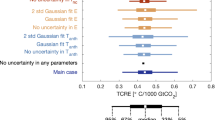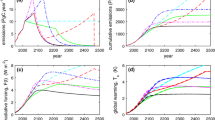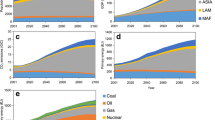Abstract
Cumulative emissions accounting for carbon-dioxide (\(\hbox {CO}_{2}\)) is founded on recognition that global warming in earth system models is roughly proportional to cumulative \(\hbox {CO}_{2}\) emissions, regardless of emissions pathway. However, cumulative emissions accounting only requires the graph between global warming and cumulative emissions to be approximately independent of emissions pathway (“path-independence”), regardless of functional relationship between these variables. The concept and mathematics of path-independence are considered for an energy-balance climate model, giving rise to a closed-form expression of global warming, together with analysis of the atmospheric cycle following emissions. Path-independence depends on the ratio between the period of the emissions cycle and the atmospheric lifetime, being a valid approximation if the emissions cycle has period comparable to or shorter than the atmospheric lifetime. This makes cumulative emissions accounting potentially relevant beyond \(\hbox {CO}_{2}\), to other greenhouse gases with lifetimes of several decades whose emissions have recently begun.






Similar content being viewed by others
Notes
The choice of perturbation in the conduct of the path independence analysis is not unique. Other choices could well be made, for example one might perturb proportionally to \(\triangle M\left( s\right)\), which would then be varying in time and be present in the integral from 0 to t. Our choice of constant perturbation \(\triangle M\left( t\right)\) for all past times \(0<s<t\) is motivated by the resulting simplicity of the analysis and its interpretation.
The minus sign in Eq. (11) is because although the airborne fraction is generally decreasing with time, we would prefer this timescale to generally take positive values.
References
Allen MR, Frame DJ, Huntingford C, Jones CD, Lowe JA, Meinshausen M, Meinshausen N (2009) Warming caused by cumulative carbon emissions towards the trillionth tonne. Nature 458:1163–1166. https://doi.org/10.1038/nature08019
Allen MR, Fuglestvedt JS, Shine KP, Reisinger A, Pierrehumbert RT, Forster PM (2016) New use of global warming potentials to compare cumulative and short-lived climate pollutants. Nat Clim Change 6:773–777. https://doi.org/10.1038/NCLIMATE2998
Bowerman NHA, Frame DJ, Huntingford C, Lowe JA, Allen MR (2011) Cumulative carbon emissions, emissions floors and short-term rates of warming: implications for policy. Philos Trans R Soc Lond A 369:45–66. https://doi.org/10.1098/rsta.2010.0288
Frame DJ, Harrington LJ, Fuglestvedt JS, Millar RJ, Joshi MM, Caney S (2019) Emissions and emergence: a new index comparing relative contributions to climate change with relative climatic consequences. Environ Res Lett 14:1–10. https://doi.org/10.1088/1748-9326/ab27fc
Friedlingstein P, Jones MW, O’Sullivan M, Andrew RM, Hauck J, Peters GP (2019) Global carbon budget 2019. Earth Syst Sci Data 11:1783–1838. https://doi.org/10.5194/essd-11-1783-2019
Fuglestvedt JS, Berntsen TK, Godal O, Sausen R, Shine KP, Skodvin T (2003) Metrics of climate change: assessing radiative forcing and emission indices. Clim Change 58:267–331. https://doi.org/10.1023/A:1023905326842
Geoffroy O, Saint-Martin D, Olivie DJL, Voldoire A, Bellon G, Tyteca S (2013a) Transient climate response in a two-layer energy-balance model: Part 1: analytical solution and parameter calibration using CMIP5 AOGCM experiments. J Clim 26:1841–1857. https://doi.org/10.1175/JCLI-D-12-00195.1
Geoffroy O, Saint-Martin D, Bellon G, Voldoire A, Olivie DJL, Tyteca S (2013b) Transient climate response in a two-layer energy-balance model. Part II: representation of the efficacy of deep-ocean heat uptake and validation for CMIP5 AOGCMs. J Clim 26:1859–1876. https://doi.org/10.1175/JCLI-D-12-00196.1
Goodwin P, Williams RG, Ridgwell A (2015) Sensitivity of climate to cumulative carbon emissions due to compensation of ocean heat and carbon uptake. Nat Geosci 8:29–34. https://doi.org/10.1038/ngeo2304
Gregory JM (2000) Vertical heat transports in the ocean and their effect on time-dependent climate change. Clim Dyn 16:501–515. https://doi.org/10.1007/s003820000059
Hall A, Cox P, Huntingford C, Klein S (2019) Progressing emergent constraints on future climate change. Nat Clim Change 9:269–278. https://doi.org/10.1038/s41558-019-0436-6
Held IM, Winton M, Takahashi K, Delworth T, Zeng F, Vallis GK (2010) Probing the fast and slow components of global warming by returning abruptly to preindustrial forcing. J Clim 23:2418–2427. https://doi.org/10.1175/2009JCLI3466.1
Herrington T, Zickfeld K (2014) Path independence of climate and carbon cycle response over a broad range of cumulative carbon emissions. Earth Syst Dyn 5:409–422. https://doi.org/10.5194/esd-5-409-2014
Lunt MF, Rigby M, Ganesan AL, Manning AJ, Prinn RG, O’Doherty S (2015) Reconciling reported and unreported HFC emissions with atmospheric observations. Proc Natl Acad Sci 112:5927–5931. https://doi.org/10.1073/pnas.1420247112
MacDougall AH, Friedlingstein P (2015) The origin and limits of the near proportionality between climate warming and cumulative CO2 emissions. J Clim 28:4217–4230. https://doi.org/10.1175/JCLI-D-14-00036.1
Matthews HD, Gillett NP, Stott PA, Zickfeld K (2009) The proportionality of global warming to cumulative carbon emissions. Nature 459:829–832. https://doi.org/10.1038/nature08047
Matthews HD, Solomon S, Pierrehumbert RT (2012) Cumulative carbon as a policy framework for achieving climate stabilization. Philos Trans R Soc Lond A 370:4365–4379. https://doi.org/10.1098/rsta.2012.0064
Meinshausen M, Meinshausen N, Hare W, Raper SCB, Frieler K, Knutti R, Frame DJ, Allen MR (2009) Greenhouse-gas emission targets for limiting global warming to 2C. Nature (London, United Kingdom) 458:1158–1162. https://doi.org/10.1038/nature08017
Meinshausen M, Smith SJ, Calvin K, Daniel JS, Kainuma MLT (2011) The RCP greenhouse gas concentrations and their extensions from 1765 to 2300. Clim Change 109:213–241. https://doi.org/10.1007/s10584-011-0156-z
Millar RJ, Fuglestvedt JS, Friedlingstein P, Grubb M, Rogelj J, Matthews HD (2017) Emission budgets and pathways consistent with limiting warming to 1.5 C. Nat Geosci 10:741–747. https://doi.org/10.1038/ngeo3031
Naik V, Jain AK, Patten KO, Wuebbles DJ (2000) Consistent sets of atmospheric lifetimes and radiative forcings on climate for CFC replacements: HCFCs and HFCs. J Geophys Res 105:6903–6914. https://doi.org/10.1029/1999JD901128
Nijsse FJ, Cox PM, Williamson MS (2020) An emergent constraint on transient climate response from simulated historical warming in CMIP6 models. Earth Syst Dyn Discuss. https://doi.org/10.5194/esd-2019-86
Orkin VL, Huie RE, Kurylo MJ (1996) Atmospheric lifetimes of HFC-143a and HFC-245fa: flash photolysis resonance fluorescence measurements of the OH reaction rate constants. J Phys Chem 100:8907–8912. https://doi.org/10.1021/jp9601882
Seshadri AK (2017a) Fast-slow climate dynamics and peak global warming. Clim Dyn 48:2235–2253. https://doi.org/10.1007/s00382-016-3202-8
Seshadri AK (2017b) Origin of path independence between cumulative CO2 emissions and global warming. Clim Dyn 49:3383–3401. https://doi.org/10.1007/s00382-016-3519-3
Shine K, Fuglestvedt JS, Hailemariam K, Stuber N (2005) Alternatives to the global warming potential for comparing climate impacts of emissions of greenhouse gases. Clim Change 68:281–302. https://doi.org/10.1007/s10584-005-1146-9
Simmonds PG, Rigby M, McCulloch A, O’Doherty S, Young D, Muhle J (2017) Changing trends and emissions of hydrochlorofluorocarbons (HCFCs) and their hydrofluorocarbon (HFCs) replacements. Atmos Chem Phys 17:4641–4655. https://doi.org/10.5194/acp-17-4641-2017
Stanley K, Say D, Muhle J, Harth C, Krummel P, Young D, O’Doherty S (2020) Increase in global emissions of HFC-23 despite near-total expected reductions. Nat Commun 396:1–6. https://doi.org/10.1038/s41467-019-13899-4
Stocker TF (2013) The closing door of climate targets. Science 339:280–282. https://doi.org/10.1126/science.1232468
Stocker TF, Qin D, Plattner G-K, Alexander LV, Allen SK (2013) Climate change 2013: the physical science basis. Contribution of working group I to the fifth assessment report of the intergovernmental panel on climate change, chap. Technical Summary. Cambridge University Press, pp 33–118
Stouffer RJ (2004) Time scales of climate response. J Clim 17:209–217. https://doi.org/10.1175/1520-0442(2004)017¡3c0209:TSOCR¿3e2.0.CO;2
van Vuuren DP, den Elzen MGJ, Lucas PL, Eickhout B, Strengers BJ (2007) Stabilizing greenhouse gas concentrations at low levels: an assessment of reduction strategies and costs. Clim Change 81:119–159. https://doi.org/10.1007/s10584-006-9172-9
Velders GJM, Fahey DW, Daniel JS, McFarland M, Andersen SO (2009) The large contribution of projected HFC emissions to future climate forcing. Proc Natl Acad Sci 106:10949–10954. https://doi.org/10.1073/pnas.0902817106
Velders GJ, Fahey DW, Daniel JS, Andersen SO, McFarland M (2015) Future atmospheric abundances and climate forcings from scenarios of global and regional hydrofluorocarbon (HFC) emissions. Atmos Environ 123:200–209. https://doi.org/10.1016/j.atmosenv.2015.10.071
Winton M, Takahashi K, Held IM (2010) Importance of ocean heat uptake efficacy to transient climate change. J Clim 23:2333–2344. https://doi.org/10.1175/2009JCLI3139.1
Zhang H, Wu J, Lu P (2011) A study of the radiative forcing and global warming potentials of hydrofluorocarbons. J Quant Spectrosc Radiat Transf 112:220–229. https://doi.org/10.1016/j.jqsrt.2010.05.012
Zickfeld K, Eby M, Matthews HD, Weaver AJ (2009) Setting cumulative emissions targets to reduce the risk of dangerous climate change. Proc Natl Acad Sci USA 106:16129–16134. https://doi.org/10.1073/pnas.0805800106
Zickfeld K, Arora VK, Gillett NP (2012) Is the climate response to carbon emissions path dependent? Geophys Res Lett 39:1–6. https://doi.org/10.1029/2011GL050205
Acknowledgements
The author thanks Prof. Govindasamy Bala, and seminar participants at Imperial College, London, and University of Exeter for helpful discussions.
Author information
Authors and Affiliations
Corresponding author
Additional information
Publisher's Note
Springer Nature remains neutral with regard to jurisdictional claims in published maps and institutional affiliations.
Supplementary Information
Below is the link to the electronic supplementary material.
Rights and permissions
About this article
Cite this article
Seshadri, A.K. Cumulative emissions accounting of greenhouse gases due to path independence for a sufficiently rapid emissions cycle. Clim Dyn 57, 787–798 (2021). https://doi.org/10.1007/s00382-021-05739-3
Received:
Accepted:
Published:
Issue Date:
DOI: https://doi.org/10.1007/s00382-021-05739-3




